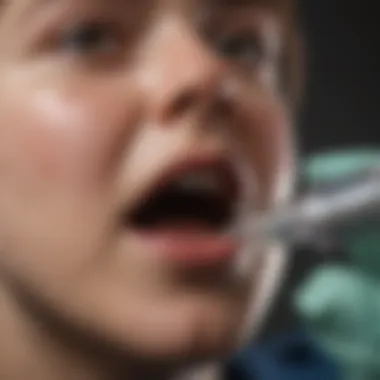Polio Vaccine Efficacy: An In-Depth Analysis


Intro
The efficacy of the polio vaccine remains a critical topic within public health discourse. This discussion delves into not just the success of various vaccine strategies but also the historical evolution that led to their development. Polio, a debilitating viral disease, primarily targets the nervous system and can result in paralysis. Eradication efforts have focused heavily on vaccination, making it essential to analyze how effective these measures really are.
Research Background
Overview of the Scientific Problem Addressed
Poliomyelitis, once a widespread disease affecting thousands, has seen a significant decline due to vaccination efforts. Understanding the scientific principles behind the polio vaccine is crucial. The vaccine has essentially become the cornerstone in the fight against this infectious disease. Fortunately, the polio vaccine's role has created a pathway for other vaccination programs.
Historical Context and Previous Studies
The journey of the polio vaccine began in the early 20th century. Notable efforts include the development of the inactivated polio vaccine by Jonas Salk in the 1950s and the oral polio vaccine by Albert Sabin in the early 1960s. These innovations have sparked numerous studies evaluating vaccine efficacy across different demographics. Previous studies consistently showed high effectiveness rates, yet challenges remain in certain regions due to vaccine hesitancy, logistical issues, and socio-economic barriers.
Findings and Discussion
Key Results of the Research
Research indicates that polio vaccination reduces the incidence of the disease by over 99% in vaccinated populations. Additionally, herd immunity plays a significant role in limiting outbreaks. Vaccination campaigns have been particularly effective in developed countries, where desired immunization coverage is often achieved.
Interpretation of the Findings
The data suggests that while the polio vaccine is effective, achieving widespread immunity poses challenges. Factors affecting efficacy include access to vaccines and public trust in health interventions. Data from ongoing global studies emphasizes a twofold approach - improving vaccine access and educating communities about the importance of vaccination. This is crucial for sustaining polio eradication efforts.
The End
Preamble to Polio and Its Public Health Impact
Polio, short for poliomyelitis, remains a significant public health concern, despite the advancements made in vaccination efforts. Understanding polio’s impact is crucial for various stakeholders, including students, researchers, and health professionals. The topic of polio highlights not only the biological aspects of the disease but also its far-reaching social and economic consequences.
Overview of Poliomyelitis
Poliomyelitis is a highly infectious viral disease primarily affecting young children. The poliovirus can spread through contaminated food and water, often leading to severe neurological complications. Most individuals infected do not show symptoms, but about one in a hundred cases leads to paralysis. The World Health Organization reports that polio can result in lifelong disabilities and is often fatal when it affects the respiratory muscles. The recognition of this disease raises the question of how to effectively address it through vaccination.
Historical Context of Polio Outbreaks
Historically, polio has been the cause of numerous outbreaks across the globe, particularly in the 20th century. Major epidemics occurred in the United States during the 1950s, prompting urgent public health responses. The introduction of the inactivated polio vaccine by Jonas Salk in 1955 was a landmark achievement. Following this, Albert Sabin developed the oral polio vaccine in the early 1960s, which expanded immunization efforts worldwide. These developments in vaccine technology illustrate how understanding the historical context of polio informs current public health strategies.
Economic and Social Implications of Polio
The economic impact of polio extends beyond healthcare costs. Individuals and families affected by the disease often face long-term financial burdens due to medical expenses and lost productivity. The social implications are equally profound, as communities rally to support affected individuals. Vaccination not only protects those at risk but also fosters a community's resilience against the virus. Thus, the importance of ongoing vaccination efforts cannot be overstated.
"Vaccines against polio not only protect individual health but also serve as a crucial tool for global health security."
In summary, comprehending poliomyelitis's historical prevalence and its global importance sets the stage for discussing the efficacy of polio vaccines. The interplay between public health, economic factors, and societal responses shapes the narrative surrounding polio vaccination initiatives.
Understanding the Polio Vaccine
Understanding the polio vaccine is crucial in the broader context of public health and disease prevention. Polio, or poliomyelitis, is a viral infection that can lead to paralysis and even death. The introduction of polio vaccines has played a significant role in drastically reducing the incidence of this disease. This section will explore various types of polio vaccines, their mechanisms, and their proven impact on controlling polio outbreaks.
Types of Polio Vaccines


Polio vaccines are essential in preventing the disease. There are two main types used globally:
Oral Polio Vaccine (OPV)
The Oral Polio Vaccine (OPV) is a live attenuated vaccine, which means it contains a weakened form of the virus. This type of vaccine has been instrumental in large-scale vaccination campaigns due to its ease of administration. OPV is delivered orally, which makes it suitable for mass immunization efforts, particularly in areas with limited healthcare infrastructure. One of the key characteristics of OPV is its ability to induce intestinal immunity, which is critical in preventing the transmission of the virus.
However, OPV comes with certain disadvantages. A notable concern is the risk of vaccine-derived poliovirus, which can occur in areas with low vaccination coverage. Despite this, OPV remains a popular choice in many regions due to its effectiveness in controlling outbreaks and its cost-effectiveness for large populations.
Inactivated Polio Vaccine (IPV)
The Inactivated Polio Vaccine (IPV) differs as it contains a killed version of the virus. This vaccine is administered through injection, which ensures that the individual gets a stronger immune response at the systemic level. A key characteristic of IPV is that it provides protection against all three types of poliovirus without the risk of vaccine-derived strains. This aspect makes it particularly appealing for countries aiming for complete eradication of polio.
Nevertheless, while IPV is effective, it has its limitations. It is more expensive and requires a healthcare setting for administration, which can pose logistical challenges, particularly in low-resource areas. Despite these difficulties, IPV's safety profile and ability to strengthen public health efforts against polio cannot be overstated.
Mechanisms of Action
The mechanisms of action of both the OPV and IPV contribute to their effectiveness. OPV multiplies in the intestine, simulating a natural infection while eliciting both humoral and cell-mediated immune responses. In contrast, IPV primarily induces a strong antibody formation without risking the transmission of the virus.
Vaccines play a pivotal role in establishing herd immunity. This happens when a large percentage of the population becomes immune, which significantly lessens the spread of the disease. The combined efforts of OPV and IPV in vaccination programs have proven effective in reducing the global polio burden.
By understanding these key elements of the polio vaccine, we can better appreciate their impact on preventing poliomyelitis. Continued advancements in vaccine development and distribution strategies will be essential to achieve global eradication of the disease.
Global Vaccination Strategies
Global vaccination strategies are crucial in the fight against poliomyelitis. These strategies ensure the systematic delivery of vaccines to populations at risk, facilitating the reduction of polio incidence rates around the world. Effective vaccination strategies must address several critical components such as timing, logistics, and community involvement. Achieving high coverage is essential to reach herd immunity, which protects those who cannot be vaccinated for medical reasons. To this end, careful planning and coordination are necessary to adapt to various local challenges, including cultural resistance and logistical constraints.
Immunization Schedules and Policies
Immunization schedules serve as foundational frameworks that outline when and how vaccines should be administered. These schedules vary greatly by region, influenced by factors such as disease prevalence, healthcare infrastructure, and demographic characteristics. The polio vaccination schedule typically starts in infancy, prioritizing rapid immunity development. The World Health Organization recommends a series of doses at specific ages to ensure long-lasting protection. The main types of schedules include:
- Routine Immunization: This involves giving vaccines according to national protocols, ensuring children get vaccinated on time during regular healthcare visits.
- Supplementary Immunization Activities (SIAs): These are campaigns aimed at boosting immunity in specific populations, often in response to an outbreak or targeted regions.
- Catch-Up Programs: These allow older children who missed routine vaccinations to receive their shots and combat any potential outbreaks.
By adhering to evidence-based schedules, countries can mitigate the risk of poliovirus transmission, ultimately steering towards the goal of global eradication.
Target Populations for Vaccination
Identifying and prioritizing target populations is a fundamental aspect of any vaccination strategy. Certain demographic groups are at a higher risk of contracting polio, making it essential to focus efforts where they are most needed. Common target populations include:
- Children under Five: This age group is the most susceptible to polio infection and related complications. High vaccination coverage among young children significantly decreases polio incidence.
- High-Risk Communities: Communities with low immunization rates or high population density often face a greater risk. Tailoring campaigns to these groups can effectively curb the potential for outbreaks.
- Travelers: Individuals traveling from areas with endemic polio must be vaccinated to prevent the virus's spread across borders.
The distribution of vaccines must be equitable and accessible, ensuring that marginalized groups receive the same level of protection as others. Engaging local leaders and healthcare providers can enhance outreach efforts. Targeting the right populations with tailored strategies can dramatically influence the success of vaccination efforts.
Efficacy of the Polio Vaccine
The efficacy of the polio vaccine is a critical area of study in understanding how effectively polio can be controlled and eventually eradicated. Polio, or poliomyelitis, is a contagious viral disease that can lead to paralysis. The vaccine's role is essential in the fight against this global health threat. Evaluating the effectiveness of the polio vaccine involves examining various factors, including its historical performance, real-world impacts on disease incidence, and the development of community immunity.
Evidence from Historical Data
Historical data provides a strong foundation for evaluating the polio vaccine's efficacy. The introduction of the polio vaccine in the mid-20th century marked a pivotal turning point in public health. After the widespread implementation of both the Oral Polio Vaccine (OPV) and the Inactivated Polio Vaccine (IPV), significant reductions in the number of polio cases were observed globally.
For example, in the United States, the incidence of polio dropped from over 21,000 cases in 1952 to less than 100 reported cases annually by the 1970s. This decline relied heavily on vaccination campaigns, which often reached over 90% of the targeted populations. The historical success stories from various countries serve as powerful evidence of the vaccine's effectiveness in eradicating polio in specific regions. These trends underscore not only the importance of a robust vaccination strategy but also the need for ongoing surveillance and booster immunizations to maintain herd immunity.


Impact on Polio Incidence Rates
The polio vaccine has shown marked impact on polio incidence rates across populations. Countries that adopted large-scale vaccination programs have witnessed dramatic decreases in polio cases. For instance, India implemented massive vaccination efforts, leading to a significant drop in cases from thousands annually to only a few sporadic instances today.
According to the World Health Organization, over 95% of reported polio cases are in countries where vaccination coverage is low. This correlation emphasizes how effective vaccination can drastically lower disease prevalence. Moreover, in regions that maintain high immunization coverage, the risk of polio outbreaks diminishes significantly.
Long-Term Immunity and Herd Immunity
Long-term immunity is a crucial aspect of the polio vaccine's efficacy. Both types of vaccines, OPV and IPV, elicit strong immune responses. OPV generally provides better intestinal immunity, which is important in preventing the spread of the virus. In contrast, IPV is effective in providing robust blood immunity, leading to fewer cases of paralysis.
Herd immunity is another essential consideration. As more individuals become immune, the overall risk for everyone decreases. This effect is particularly evident in communities with high vaccination rates, where the probability of virus transmission is reduced. Effective herd immunity can prevent outbreaks, protecting those who cannot be vaccinated, such as infants or individuals with certain medical conditions.
"Vaccination not only protects individuals; it establishes a barrier that can prevent the spread of polio in communities."
In summary, the efficacy of the polio vaccine is supported by extensive historical evidence, significant reductions in polio incidence rates, and the creation of both long-term and herd immunity. These factors highlight the necessity of ongoing vaccination efforts to control and ultimately eradicate polio.
Challenges in Vaccination Efforts
The effectiveness of the polio vaccine cannot be fully realized without addressing the challenges that impede vaccination efforts. These challenges are significant, as they not only affect vaccine uptake but also impact global eradication goals. Understanding these barriers is essential for developing strategies that can enhance vaccination coverage and ultimately lead to the complete control of poliomyelitis.
Vaccine Hesitancy and Public Perception
Vaccine hesitancy is a critical hurdle facing vaccination campaigns. Many people hold suspicions about the safety and efficacy of the polio vaccine. Misinformation and misconceptions about vaccines can significantly reduce participation in immunization programs.
Factors influencing this hesitancy usually stem from cultural, religious, or historical contexts. Some communities may associate vaccines with negative experiences or believe in alternative health practices. This is compounded by social media that spreads misleading information often faster than accurate data about vaccines' benefits. To tackle this issue, health educators must engage with communities. Building trust through transparent communication and addressing concerns is vital. Public forums can provide an avenue for dialogue, helping to dispel fears and promote a better understanding of vaccine safety.
Logistical and Infrastructure Barriers
Logistical and infrastructure issues further complicate vaccination efforts. In many regions, especially in developing countries, inadequate healthcare infrastructure can lead to delays in vaccine delivery. Supply chains may be disrupted, and cold storage for vaccines is often lacking, which is necessary for the viability of certain types of polio vaccines.
Additionally, the lack of trained healthcare personnel hampers efficient vaccination campaigns. Remote and rural areas may not have easy access to vaccination centers, necessitating mobile clinics that are not always available due to funding or resource limitations. To overcome these barriers, investments in health infrastructure are crucial. Establishing partnerships with non-governmental organizations can help expand outreach and improve logistics to ensure that vaccines are delivered safely and effectively.
Emerging Polio Strains and Vaccine-Derived Polio
Emerging polio strains present a complex challenge to eradication efforts. While the vaccines are effective against wild poliovirus, they may not always provide adequate protection against vaccine-derived poliovirus (VDPV). This occurs when the weakened virus in the oral polio vaccine mutates and regains virulence. Communities with low vaccination coverage are particularly at risk, which can lead to outbreaks of polio.
Monitoring and surveillance are critical to identify these strains early. Global health organizations must focus on research that aims to develop new vaccine formulations capable of addressing these mutations. Enhancing vaccination coverage in under-immunized areas will also mitigate the risk of VDPV outbreaks.
"To truly combat polio, we must engage with communities and break down the barriers that hinder vaccination efforts."
Innovative solutions and proactive strategies can help ensure that the benefits of polio vaccination reach every corner of the globe.
Current Trends in Polio Vaccination
The importance of current trends in polio vaccination cannot be understated. As we approach the possibility of global eradication of poliomyelitis, understanding the evolving landscape of vaccination efforts remains crucial. The trends reflect both challenges and opportunities in the fight against polio. With various strategies being implemented and innovative technologies emerging, it is essential to assess the effectiveness of these approaches in protecting populations and addressing vulnerabilities more resiliently.
Global eradication campaigns
Global eradication campaigns for poliomyelitis have been active since the late 20th century, spearheaded by organizations such as the World Health Organization (WHO) and UNICEF. These initiatives are not just about administering vaccines. They involve comprehensive strategies that mobilize communities, track virus transmission, and ensure high vaccination coverage.
One significant campaign is the Global Polio Eradication Initiative, launched in 1988. This program combines resources from multiple partners to vaccinate children worldwide. The goal is to reach every child, particularly in regions where poliovirus is still endemic. Campaign activities include:


- National immunization days where millions of children are vaccinated within a short time frame.
- Surveillance efforts to detect poliovirus cases quickly, allowing for rapid responses to outbreaks.
- Community engagement which helps cultivate trust and dispel vaccine hesitancy.
Despite these successes, challenges persist. Polio remains endemic in a few countries, including Afghanistan and Pakistan. In these areas, security issues and misinformation about vaccines undermine efforts. Nevertheless, continued investment in eradication campaigns presents the best chance for the world to eliminate this disease.
Innovations in Vaccine Development
Innovations in vaccine development are critical for enhancing the efficacy and safety of polio vaccines. The traditional vaccines, namely the Oral Polio Vaccine (OPV) and Inactivated Polio Vaccine (IPV), have proven effective, but ongoing advancements adapt them for broader use. Recent trends focus on refining existing vaccines and exploring new technologies.
Key innovations include:
- Monovalent vaccines, which are designed to target specific strains of the poliovirus more effectively.
- mRNA-based vaccines, inspired by their success against COVID-19, hold potential for rapid development and deployment during outbreaks.
- Next-generation oral vaccines, designed to reduce the risk of vaccine-derived poliovirus while maintaining immunity levels.
These developments are pivotal in fostering trust in vaccination programs. Improved vaccine formulations can lead to increased public confidence, ensuring that more children receive the lifesaving protection offered by these vaccines. For the polio eradication strategy, staying at the forefront of vaccine innovation is not merely beneficial; it is essential.
Future Directions in Polio Control
The ongoing efforts to combat polio highlight the necessity for both innovation in vaccine technology and advancements in public health policy. As the global community makes strides toward the eradication of poliomyelitis, it becomes pivotal to examine future directions in polio control. This section discusses various elements that are crucial for sustaining progress and addressing existing challenges in polio management. A thorough understanding of new vaccine formulations and improved public health policies will play a vital role in the future of polio eradication efforts.
Research on New Vaccine Formulations
Exploration into new vaccine formulations is imperative to enhance the effectiveness of polio vaccination. Current research trends focus on developing updated versions of oral polio vaccine (OPV) and inactivated polio vaccine (IPV). Researchers aim for formulations that offer longer-lasting immunity and require fewer doses, thereby improving compliance rates among target populations.
The investigation into heterologous vaccines also presents a promising avenue. These vaccines leverage different strains to boost immune response. Recent studies have noted that alternative formulations could potentially address vaccine-derived polio cases.
Some areas for in-depth research include:
- Stability: Enhancing shelf life under various environmental conditions to facilitate distribution, especially in low-resource settings.
- Delivery Methods: Innovations in delivery systems, such as micro-needle patches, which could simplify the vaccination process and overcome hesitancy in needle usage.
- Combination Vaccines: Formulating combination vaccines that protect against multiple diseases, potentially increasing uptake.
Advancements in Public Health Policy
Effective public health policy frameworks remain essential to the success of polio vaccination campaigns. Future directions in policy development must reflect flexibility and adaptability in the face of emerging challenges. Thoughtful policies will not only promote vaccination but also ensure the sustainability of eradication efforts.
Key considerations for public health policies include:
- Data-Driven Approaches: Improving data collection systems will enable governments to tailor their vaccination strategies effectively.
- Community Engagement: Policies that foster community involvement can help mitigate vaccine hesitancy, a known barrier to immunization.
- Partnerships: Collaborative efforts with NGOs, educational institutions, and local communities can enhance outreach. Mobilizing resources and sharing best practices will increase the policy's effectiveness.
"The future of polio eradication lies not just in the science of vaccines but also in the art of policy-making and community partnership."
The End
The conclusion of this article stands as a critical reflection on the multifaceted nature of polio vaccine efficacy. It synthesizes the various elements previously discussed, emphasizing the significance of vaccines in combating poliomyelitis. Understanding the efficacy of the polio vaccine is essential for public health stakeholders, researchers, and policymakers alike. This section highlights the benefits and considerations that surround the topic.
Summary of Vaccine Efficacy
The efficacy of the polio vaccine has been well-documented through extensive historical data and contemporary studies. Vaccines like the Oral Polio Vaccine (OPV) and Inactivated Polio Vaccine (IPV) have proven to reduce incidence rates significantly. Global vaccination campaigns led to dramatic declines in polio cases. Some key points regarding vaccine efficacy include:
- Robust data showing reductions in poliomyelitis cases in vaccinated populations.
- Long-term immunity provided by both OPV and IPV, which supports herd immunity in communities.
- The ability of vaccines to prevent both wild and vaccine-derived strains of the virus.
"The polio vaccine has transformed public health landscapes worldwide, showcasing the power of immunization in disease eradication."
These points contribute to a better understanding of how vaccination has not only curbed existing cases but also paved the way for potential global eradication.
The Importance of Continued Vigilance
Despite successes, the journey towards complete eradication of polio is not over. Continued vigilance is, therefore, crucial for several reasons:
- Emerging strains of the virus can lead to outbreaks if vaccination rates decline.
- Vaccine hesitancy can undermine immunization efforts, necessitating ongoing education and outreach.
- Logistical challenges still exist in some regions, demanding coordinated efforts to enhance infrastructure.
It is clear that the work must not halt. Public health initiatives must evolve to sustain and enhance public confidence in vaccination programs. This overarching need for vigilance underscores the importance of continuous monitoring, community engagement, and scientific advancement to ensure that the hard-won gains against poliomyelitis are maintained.







